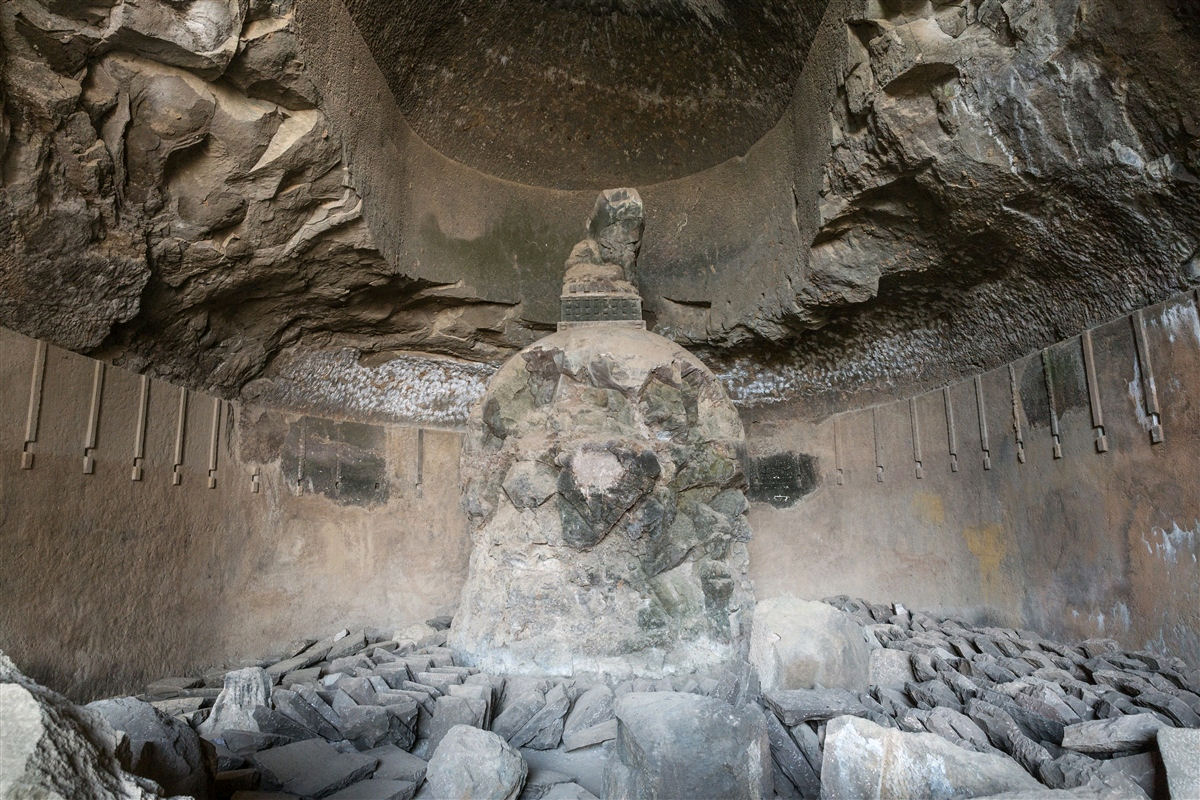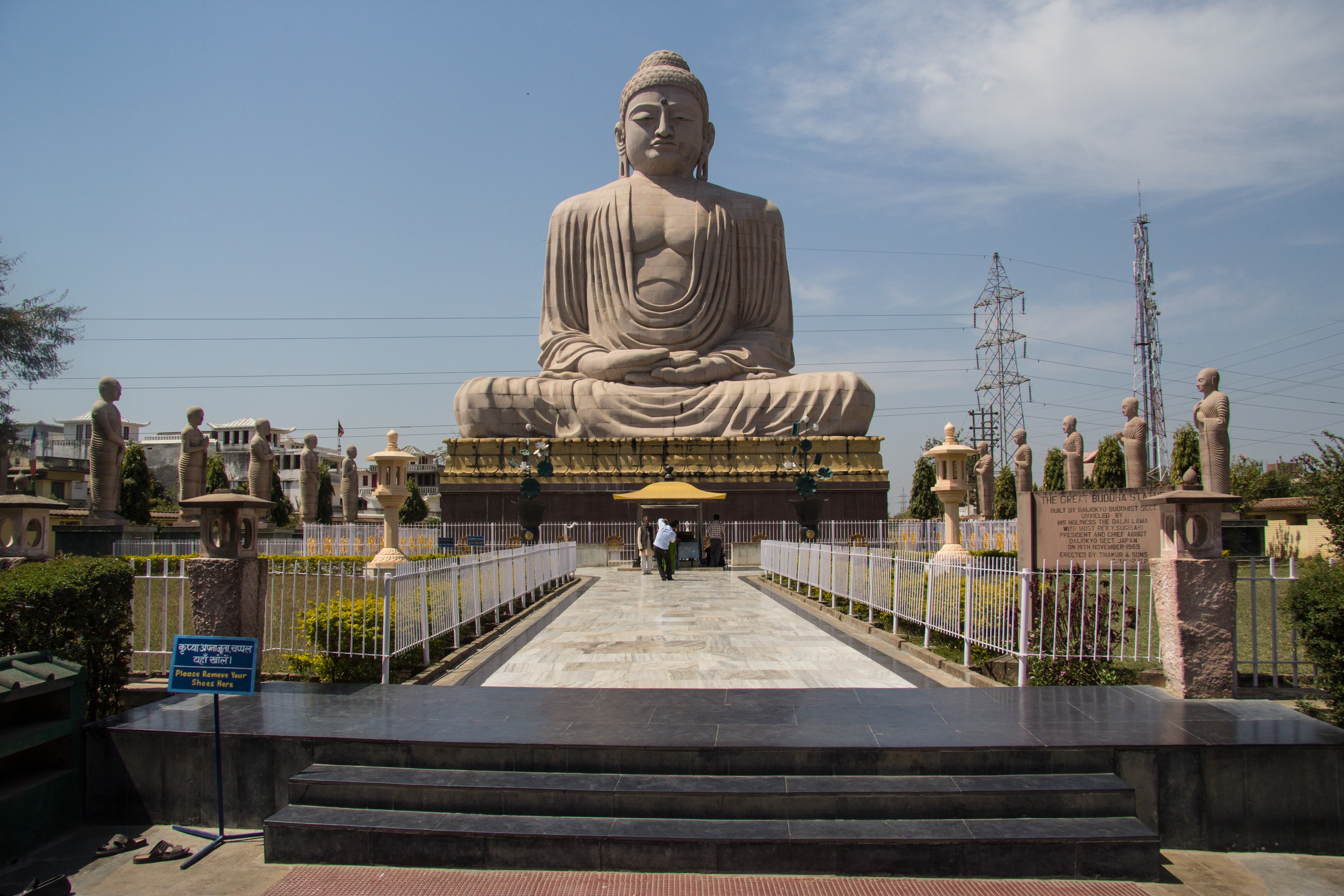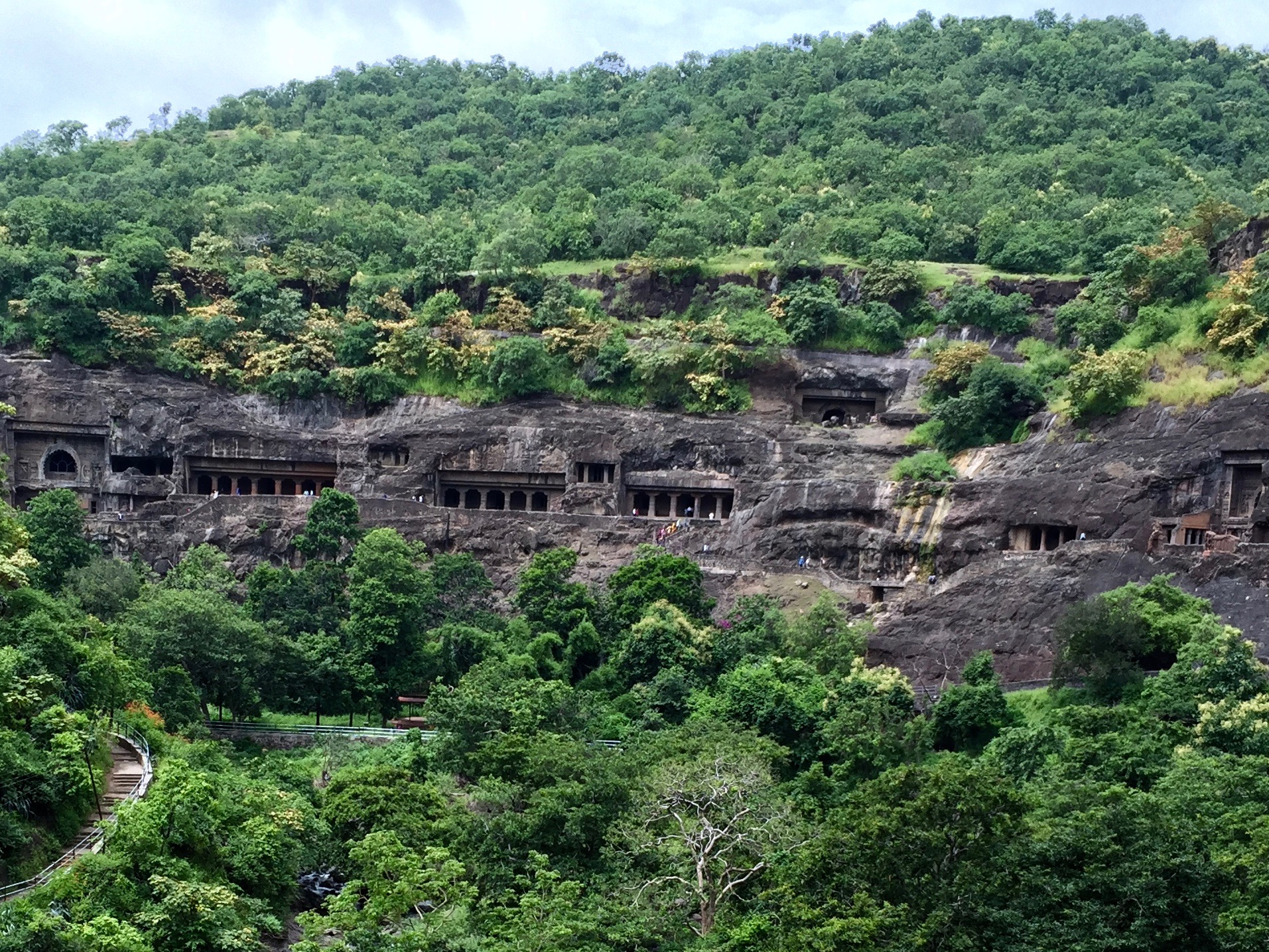|
Kondana Caves
The Kondana Caves are located in the small village of Kondana, 33 km north of Lonavala and 16 km northwest of Karla Caves. This cave group has 16 Buddhist caves. The caves were excavated in first century B.C. The construction on wooden pattern is notable. One can reach the cave by descending from Rajmachi village. The cave only one inscription on the front of the Chaitya, which gives information about donors. Description About 14 km from the Karjat station, on Central Railway, and at the base of the old hill fort of Rajmachi, is the Kondane group of caves, first brought to notice in the 19th century by Vishnu Sastri, and soon after visited by Mr. Law, then collector of Thana. They are in the face of a steep scarp, and quite hidden from view by the thick forest in front of them. Water trickles down over the face of the rock above them during a considerable part even of the dry season, and has greatly injured them. So much so indeed that it is now difficult to dete ... [...More Info...] [...Related Items...] OR: [Wikipedia] [Google] [Baidu] |
Maharashtra
Maharashtra (; , abbr. MH or Maha) is a state in the western peninsular region of India occupying a substantial portion of the Deccan Plateau. Maharashtra is the second-most populous state in India and the second-most populous country subdivision globally. It was formed on 1 May 1960 by splitting the bilingual Bombay State, which had existed since 1956, into majority Marathi-speaking Maharashtra and Gujarati-speaking Gujarat. Maharashtra is home to the Marathi people, the predominant ethno-linguistic group, who speak the Marathi language, the official language of the state. The state is divided into 6 divisions and 36 districts, with the state capital being Mumbai, the most populous urban area in India, and Nagpur serving as the winter capital, which also hosts the winter session of the state legislature. Godavari and Krishna are the two major rivers in the state. Forests cover 16.47 per cent of the state's geographical area. Out of the total cultivable land in the ... [...More Info...] [...Related Items...] OR: [Wikipedia] [Google] [Baidu] |
Façade
A façade () (also written facade) is generally the front part or exterior of a building. It is a loan word from the French (), which means ' frontage' or ' face'. In architecture, the façade of a building is often the most important aspect from a design standpoint, as it sets the tone for the rest of the building. From the engineering perspective, the façade is also of great importance due to its impact on energy efficiency. For historical façades, many local zoning regulations or other laws greatly restrict or even forbid their alteration. Etymology The word is a loanword from the French , which in turn comes from the Italian , from meaning 'face', ultimately from post-classical Latin . The earliest usage recorded by the ''Oxford English Dictionary'' is 1656. Façades added to earlier buildings It was quite common in the Georgian period for existing houses in English towns to be given a fashionable new façade. For example, in the city of Bath, The Bunch of Grapes ... [...More Info...] [...Related Items...] OR: [Wikipedia] [Google] [Baidu] |
Buddhist Monasteries In India
Buddhism ( , ), also known as Buddha Dharma and Dharmavinaya (), is an Indian religion or philosophical tradition based on teachings attributed to the Buddha. It originated in northern India as a -movement in the 5th century BCE, and gradually spread throughout much of Asia via the Silk Road. It is the world's fourth-largest religion, with over 520 million followers (Buddhists) who comprise seven percent of the global population. The Buddha taught the Middle Way, a path of spiritual development that avoids both extreme asceticism and hedonism. It aims at liberation from clinging and craving to things which are impermanent (), incapable of satisfying ('), and without a lasting essence (), ending the cycle of death and rebirth (). A summary of this path is expressed in the Noble Eightfold Path, a training of the mind with observance of Buddhist ethics and meditation. Other widely observed practices include: monasticism; " taking refuge" in the Buddha, the , and the ... [...More Info...] [...Related Items...] OR: [Wikipedia] [Google] [Baidu] |
Buddhist Pilgrimage Sites In India
In religion and spirituality, a pilgrimage is a long journey or search of great moral significance. Sometimes, it is a journey to a sacred place or to a shrine of importance to a person's beliefs and faith. Members of every major religion participate in pilgrimages. A person who makes such a journey is called a pilgrim. There are number of historical Buddhist pilgrimage sites in the Republic of India. Places associated with the life of Buddha Primary sites Buddhism offers four primary sites of pilgrimage: Lumbini (birthplace of the Buddha), Bodh Gaya (the site where the Buddha attained enlightenment), Sarnath (the location of the Buddha’s first sermon), and Kushinagar (the location where the Buddha attained parinirvana). All of these sites are located in India except Lumbini, which is located in southern Nepal. File:Exterior view of the Mahabodhi Temple.jpg, "Maha Bodhi Temple" at Bodh Gaya File:Dhamek Stupa, Sarnath.jpg, Dhamek Stupa, Sarnath File:Ancient Buddhi ... [...More Info...] [...Related Items...] OR: [Wikipedia] [Google] [Baidu] |
Former Populated Places In India
A former is an object, such as a template, gauge or cutting die, which is used to form something such as a boat's hull. Typically, a former gives shape to a structure that may have complex curvature. A former may become an integral part of the finished structure, as in an aircraft fuselage, or it may be removable, being using in the construction process and then discarded or re-used. Aircraft formers Formers are used in the construction of aircraft fuselage, of which a typical fuselage has a series from the nose to the empennage, typically perpendicular to the longitudinal axis of the aircraft. The primary purpose of formers is to establish the shape of the fuselage and reduce the column length of stringers to prevent instability. Formers are typically attached to longerons, which support the skin of the aircraft. The "former-and-longeron" technique (also called stations and stringers) was adopted from boat construction, and was typical of light aircraft built until the adv ... [...More Info...] [...Related Items...] OR: [Wikipedia] [Google] [Baidu] |
Indian Rock-cut Architecture
Indian rock-cut architecture is more various and found in greater abundance in that country than any other form of rock-cut architecture around the world. Rock-cut architecture is the practice of creating a structure by carving it out of solid natural rock. Rock that is not part of the structure is removed until the only rock left makes up the architectural elements of the excavated interior. Indian rock-cut architecture is mostly religious in nature. There are more than 1,500 known rock-cut structures in India. Many of these structures contain artwork of global importance, and most are adorned with exquisite stone carvings. These ancient and medieval structures represent significant achievements of structural engineering and craftsmanship. The effort expended often astonishes visitors, but seen from one aspect, a rock-cut structure is a decorated rock quarry; most of the stone removed was typically put to economic use elsewhere. In India, caves have long been regarded as sac ... [...More Info...] [...Related Items...] OR: [Wikipedia] [Google] [Baidu] |
Caves Of Maharashtra
A cave or cavern is a natural void in the ground, specifically a space large enough for a human to enter. Caves often form by the weathering of rock and often extend deep underground. The word ''cave'' can refer to smaller openings such as sea caves, rock shelters, and grottos, that extend a relatively short distance into the rock and they are called ''exogene'' caves. Caves which extend further underground than the opening is wide are called ''endogene'' caves. Speleology is the science of exploration and study of all aspects of caves and the cave environment. Visiting or exploring caves for recreation may be called ''caving'', ''potholing'', or ''spelunking''. Formation types The formation and development of caves is known as ''speleogenesis''; it can occur over the course of millions of years. Caves can range widely in size, and are formed by various geological processes. These may involve a combination of chemical processes, erosion by water, tectonic forces, microorga ... [...More Info...] [...Related Items...] OR: [Wikipedia] [Google] [Baidu] |
Buddhist Caves In India
The Buddhist caves in India. Maharashtra state Aurangabad Dist. Ellora caves form an important part of Indian rock-cut architecture, and are among the most prolific examples of rock-cut architecture around the world. There are more than 1,500 known rock cut structures in India, out of which about 1000 were made by Buddhists (mainly between 200 BCE and 600 CE), 300 by Hindus (from 600 CE to 1200 CE), and 200 by Jains (from 800 CE to 1200 CE). Many of these structures contain works of art of global importance, and many later caves from the Mahayana period are adorned with exquisite stone carvings. These ancient and medieval structures represent significant achievements of structural engineering and craftsmanship. In India, caves have long been regarded as places of sanctity. Caves that were enlarged or entirely man-made were felt to hold the same sanctity as natural caves. In fact, the sanctuary in all Indian religious structures, even free-standing ones, retains the same cave-like f ... [...More Info...] [...Related Items...] OR: [Wikipedia] [Google] [Baidu] |
Kondana Caves Vihara Veranda
Sinhagad is an ancient hill fortress located at around 49 km southwest of the city of Pune, India. Previously known as ''Kondhana'', the fort had been the site of many battles, most notably the Battle of Sinhagad in 1670. The Sinhagad (''Lion's Fort'') was strategically built to provide natural protection due to its very steep slope The walls and bastions were constructed only at key places. There are two gates to enter the fort, the Kalyan Darwaza and Pune Darwaza, positioned at the south-east and northeast ends. The fort was also strategically located at the centre of a string of other Maratha Empire forts such as Rajgad Fort, Purandar Fort and Torna Fort. Geography Perched on an isolated cliff of the Bhuleswar range in the Sahyadri Mountains, the fort is situated on a hill about 760 metres above ground and 1,312 metres above mean sea level. History Early history Some of the information available about the fort, suggests that it could have been built 2000 years ag ... [...More Info...] [...Related Items...] OR: [Wikipedia] [Google] [Baidu] |
Anta (architecture)
An anta (pl. antæ, antae, or antas; Latin, possibly from ''ante'', "before" or "in front of"), or sometimes parastas (pl. parastades), is an architectural term describing the posts or pillars on either side of a doorway or entrance of a Greek temple – the slightly projecting piers which terminate the walls of the naos. It differs from the pilaster, which is purely decorative, and does not have the structural support function of the anta. Anta In contrast to columns or pillars, antae are directly connected with the walls of a temple. They owe their origin to the vertical posts of timber employed in the early, more primitive palaces or temples of Greece, as at Tiryns and in the Temple of Hera at Olympia. They were used as load-bearing structures to carry the roof timbers, as no reliance could be placed on walls built with unburnt brick or in rubble masonry with clay mortar. Later, they became more decorative as the materials used for wall construction became sufficient to su ... [...More Info...] [...Related Items...] OR: [Wikipedia] [Google] [Baidu] |
Kondana Vihara
Sinhagad is an ancient hill fortress located at around 49 km southwest of the city of Pune, India. Previously known as ''Kondhana'', the fort had been the site of many battles, most notably the Battle of Sinhagad in 1670. The Sinhagad (''Lion's Fort'') was strategically built to provide natural protection due to its very steep slope The walls and bastions were constructed only at key places. There are two gates to enter the fort, the Kalyan Darwaza and Pune Darwaza, positioned at the south-east and northeast ends. The fort was also strategically located at the centre of a string of other Maratha Empire forts such as Rajgad Fort, Purandar Fort and Torna Fort. Geography Perched on an isolated cliff of the Bhuleswar range in the Sahyadri Mountains, the fort is situated on a hill about 760 metres above ground and 1,312 metres above mean sea level. History Early history Some of the information available about the fort, suggests that it could have been built 2000 years ag ... [...More Info...] [...Related Items...] OR: [Wikipedia] [Google] [Baidu] |

.jpg)





.jpg)
